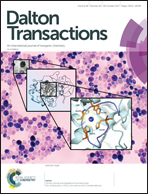Polyethyleneimine methylphosphonate: towards the design of a new class of macromolecular actinide chelating agents in the case of human exposition†
Abstract
The use of uranium and to a minor extent plutonium as fuel for nuclear energy production or as components in military applications is under increasing public pressure. Uranium is weakly radioactive in its natural isotopy but its chemical toxicity, combined with its large scale industrial utilization, makes it a source of concern in terms of health impact for workers and possibly the general population. Plutonium is an artificial element that exhibits both chemical and radiological toxicities. So far, uranium (under its form uranyl, U(VI)) or plutonium (as Pu(IV)) decorporation or protecting strategies based on molecular design have been of limited efficiency to remove the actinide once incorporated after human exposure. In all cases, after human exposure, plutonium and uranium are retained in main target organs (liver, kidneys) as well as skeleton although they exhibit differences in their biodistribution. Polymers could represent an alternative strategy as their tropism for specific target organs has been reported. We recently reported on the complexation properties of methylcarboxylated polyethyleneimine (PEI-MC) with uranyl. In this report we extend our work to methylphosphonated polyethyleneimine (PEI-MP) and to the comparison between actinide oxidation states +IV (thorium) and +VI (uranyl). As a first step, thorium (Th(IV)) was used as a chemical surrogate of plutonium because of the difficulty in handling the latter in the laboratory. For both cations, U(VI) and Th(IV), the uptake curve of PEI-MP was recorded. The functionalized PEI-MP exhibits a maximum loading capacity comprised of between 0.56 and 0.80 mg of uranium (elemental) and 0.15–0.20 mg of thorium (elemental) per milligram of PEI-MP. Complexation sites of U(VI) and Th(IV) under model conditions close to physiological pH were then characterized with a combination of Fourier transform Infra Red (FT-IR) and Extended X-Ray Absorption Fine Structure (EXAFS). Although both cations exhibit different coordination modes, similar structural parameters with phosphonate functions were obtained. For example, the coordination sites are composed of fully monodentate phosphonate functions of the polymer chains. These physical chemical data represent a necessary basic chemistry approach before envisioning further biological evaluations of PEI-MP polymers towards U(VI) and Pu/Th(IV) contamination.



 Please wait while we load your content...
Please wait while we load your content...